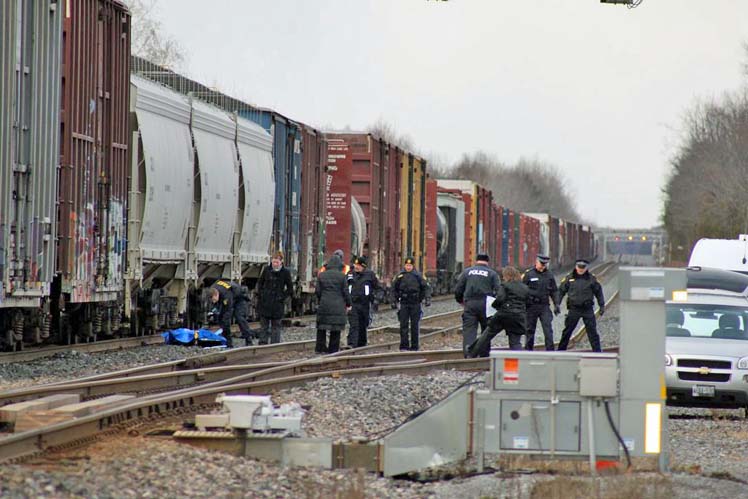
of a collision in Northumberland - 2012 Joyce Cassin.
Canada - Canada's been tracking the largest cause of death on its federally regulated railways over the past decade without launching a
substantial number of investigations and without a national plan to prevent further fatalities.
The largest category of death on these railways, routes used by Canadian Pacific Railway (CP), Canadian National Railway (CN), VIA Rail (VIA), Burlington
Northern Santa Fe (BNSF) and the like , is so-called "trespassing" deaths.
From 2007 to 2017, the Transportation Safety Board (TSB) recorded 499 of them, roughly double the number of deaths at train crossings.
Including both accidental and intentional deaths such as suicides, "trespass" deaths make up 60 percent of all rail fatalities
nationwide.
Yet public records show the TSB, Canada's transportation investigative agency, has only conducted two trespass investigations since 1996, despite the board's
own policy recommending the deployment of investigators in cases of serious injury or death.
The most recent investigation was initiated in March, with the TSB identifying a pattern in three incidents this spring in Ontario.
All three incidents took place around well-used footpaths, an ostensible sign of safety that invited people to walk around active train tracks.
One such victim was Khelyse Crowe-Kasule from Hamilton.
The eight-year-old and her friends were playing around the tracks running through their residential neighbourhood when a stopped CP train started
moving.
The TSB suggested the train had been moving at about 8 kph when it ran over Crowe-Kasule, severing much of her right leg.
Her first words to her horrified father were, "Daddy, please don't be mad at me."
The first police officer who arrived applied a tourniquet to Crowe-Kasule's leg, an act that police believe saved her life.
Transport Canada (TC), the federal regulator for railways, does not require companies to build or maintain fences along their tracks to prevent access, whether
intentional or not.
The department also does not regulate safety features at platforms and stations.
The family's lawyer, Darcy Merkur, said the only barrier that separated the track from a residential neighbourhood is a "decrepit"
fence.
"I don't agree with the use of the word trespass at all. Trespass suggests there were large fences preventing people from accessing the area and they
acted deviously to access the area, which is not the case at all," said Merkur in an interview.
"What it really is about is the rail companies' responsibility to prevent access in these situations where the children are enamoured by these trains,
don't appreciate the risks because they are children, and are injured."
TSB director of investigations for rail Kirby Jang confirmed his organization has, for the most part, not been investigating these types of
deaths.
Instead, many of the TSB's investigations focus on events such as derailments, collisions at rail crossings, employee injuries and deaths.
"Our official investigations have not included the trespassing categories. Many of these are intended actions. That is part of the consideration we do
look into," Jang said in an interview.
"One thing that we do is issue what we refer to as safety advisory letters, particularly if we've identified a location that has a particularly high
incidence of trespassing, or a recent fatality where it was not an intended action."
Peter Hickli, senior regional investigator for rail with the TSB in Vancouver, said the body uses its discretion to decide which cases to look into, generally
leaving it to provincial medical examiners to examine "trespass" deaths.
"The trespasser issue is a complex one," Hickli said.
"Often, it involved people using this as a method to end their life. The issue on a whole is a difficult one to investigate."
The hundreds of trespass deaths, and the lack of information on why the deaths are occurring, were documented in a TC review of Canada's Railway Safety Act
published this June.
The report predicts that the number of deaths is likely to grow without intervention but stopped short of recommending new regulation.
In an interview, Richard Paton, chair of the Railway Safety Act review panel, said both provincial and federal levels of government need to create a
comprehensive strategy to prevent further accidents and deaths.
"This is a serious problem," Paton said.
"The number of accidents caused by the traditional things, such as rail track being cracked, signals not working, wheels not working, these are all
declining due to technology investments, better enforcement. Trespassing and crossing accidents are not declining."
Helen Vassilakos, co-founder of advocacy group Safe Rail Communities, called for the TSB to investigate more trespass incidents.
"If they're not investigating these incidents, how do we know enough is being done to stop them?" Vassilakos said in an interview.
"We would hope they would investigate them in the future and there would be some sort of legislation in place to at least have a baseline regulation,
legislation, in place for the railways to follow."
CP and CN together own approximately 75 percent of nationally regulated track in the country.
Neither organization provided an interview, instead pointing to trespass prevention initiatives undertaken by Operation Lifesaver, a group funded by TC and the
Railway Association of Canada.
Sarah Mayes, national director with Operation Lifesaver, agreed with critics that the TSB should begin identifying and publishing information on suicides,
which Operation Lifesaver and transit agencies believe to be one of the biggest cause of deaths on the tracks.
"This would be valuable information for the TSB to collect and publish, as it would assist railways and organizations such as Operation Lifesaver in
identifying areas of concern for railway suicide across Canada and in planning interventions accordingly," Mayes said.
"Anything that we can do to better understand and prevent these incidents from happening would alleviate immense suffering."
TC announced on 1 Aug 2018 it is investing $20 million to fund 105 rail safety projects with a focus on preventing deaths at crossings, along with an
educational component to deter trespassing.
In a statement, TC said federal Transport Minister Marc Garneau met with railway safety stakeholders on 5 Jul 2018 as part of discussions on implementing
recommendations from Paton's review.
"Under the Railway Safety Act, railway companies are responsible for ensuring the safety of their rail line infrastructure, railway equipment, and
operations," TC said in the statement.
"Trespassing mitigation is a shared responsibility. TC encourages railways to collaborate with all interested stakeholders, including municipalities and
landowners adjacent to the railway."
Michael Mui.
provisions in Section 29 of the Canadian
Copyright Modernization Act.

